the place where Paleontology and Paleoanthropology meets Philately
Denmark
Fossils, contributors to Paleontology science on stamps and postmarks of Denmark
| << previous country | back to index | next country >> |
Contents:
- Country overview
- Philately of Denmark
- Official stamps of Denmark related to Paleontology and Paleoanthropology
- Other stamps of Denmark to consider
- Postal stationeries of Denmark related to Paleontology and Paleoanthropology
- Postmarks and meter franking of Denmark related to Paleontology and Paleoanthropology
- References
- Acknowledgements
Denmark is a Scandinavian country in Europe. The southernmost of the Nordic countries, it is south-west of Sweden and south of Norway, and bordered to the south by Germany.
The Kingdom of Denmark is a sovereign state that comprises Denmark proper and two autonomous constituent countries in the North Atlantic Ocean: the Faroe Islands and Greenland.
Denmark has an area of 42,924 square kilometers and a population of 5.7 million. The country consists of a peninsula, Jutland, and an archipelago of 443 named islands, of which around 70 are inhabited. The islands are characterized by flat, arable land and sandy coasts, low elevation and a temperate climate.
The Kingdom of Denmark does not have a single unified judicial system – Denmark has one system, Greenland another, and the Faroe Islands a third. [R1]
Denmark's postal history begins with an ordinance of 24 December 1624 by King Christian IV, establishing a national postal service. This service consisted of nine main routes, and was to be operated by the mayor of Copenhagen and several guilds. Initially the mail was carried by foot, with riders being used after 1640. The first postage stamps were introduced on 1 April 1851, by a law passed on 11 March. [R2]
So far there are only a few stamps of Denmark related to Paleontology.
Official stamps of Denmark related to Paleontology: fossils, prehistoric animals
| 05.11.1998 " Drawings of fossil animals from old books - Historiske Fossile" | ||
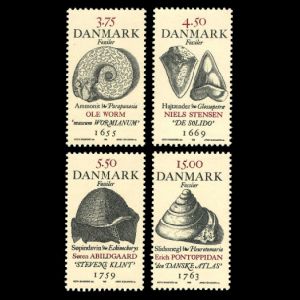
|
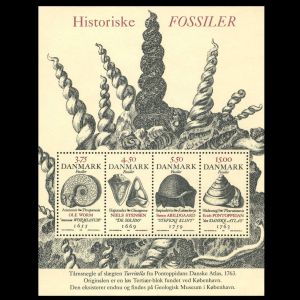
|
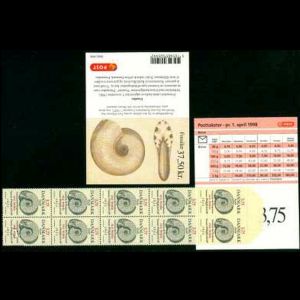
|
| 25.03.2009 " Danish Nature" [1] | ||
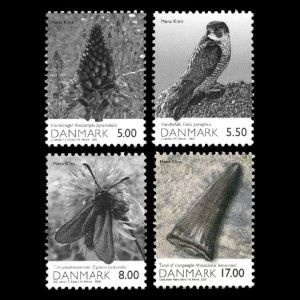 |
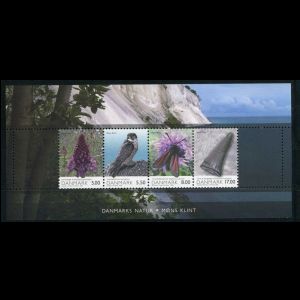 |
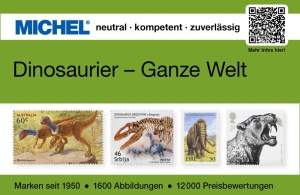 |
Notes:
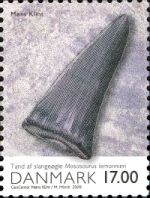
|
|
Mosasaur teeth on Danish Nature stamp of Denmark 2009. MiNr.: 1527 Scott: 1433 |
Three teeth found on the beach at Moens Klint in 2007 turned out to be from a Mosasaurus lemonnieri, the most feared predator of the Cretaceous Period, a voracious 16-metre monster with razor-sharp teeth that hunted and devoured sharks, octopuses and even smaller members of its own species.
One of the three teeth found on Moens Klint is featured on the DKK 17.00 stamp (see on the right).
The tooth is now on display in the GeoCenter Moens Klint, alongside a lifelike copy of the killer creature and information about how it hunted and bred. There are several exhibits dedicated to natural history of the region.
Other stamps of Denmark to consider: contributors to Paleontology science
| 25.09.1969 "Niels Stensen" [A1] | 18.02.1988 "Ole Worm" [A2] | |
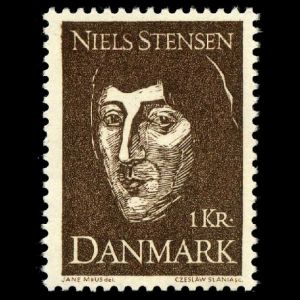 |
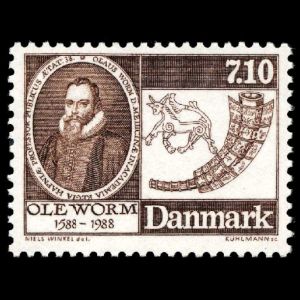 |
|
Notes:
[A1] Neils Stensen , also known as Nicholas Steno (1638 - 1686), was a Danish pioneer in both anatomy and geology, who also studied fossils, especially shark teeth (one such fossil teeth is depicting on stamp from 1998). He noted that the shark's teeth bore a striking resemblance to certain stony objects, found embedded within rock formations, that his learned contemporaries were calling glossopetrae or "tongue stones" are actually teeth of extinct animals.
MOreover, he is also developed several tools that modern geologists use in stratigraphy – having described several of the principles of relative age dating including superposition. Superposition is the idea that in a series of undeformed rock layers, the oldest layer is at the base of the sequence and the layers become progressively younger towards the top of the sequence. [R3]
[A2] Ole Worm (1588-1654) was originally a physician in Copenhagen. He became famous for his work as a Naturalist and the founder of Denmark’s very first museum.
The museum was named after himself, "Museum Wormianum" and has some collections of fossils. Ammonit Parapuzosia from collection of the museum is shown on stamp with face value of 3.75 at "Drawings of fossil animals from old books - Historiske Fossile" set from 1998. [R4]
Postal stationeries of Denmark related to Paleontology: fossils, prehistoric animals
| 05.11.1998 " Drawings of fossil animals from old books - Historiske Fossile" | ||
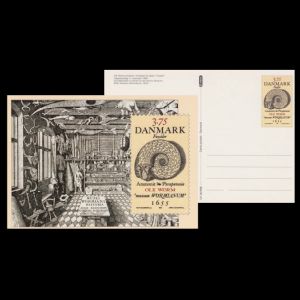
|
|
|
Postmarks and meter franking of Denmark related to Paleontology: prehistoric animals
| 1997 - 1998 "Dinosaur Exhibition - Egg & Kids" | ||
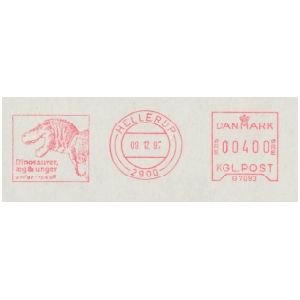
|
|
|
References:
- [R1] Denmark: Wikipedia, WikiTravel, FlagCounter.
- [R2] Postal History and Philately of Denmark:
Wikipedia,
Links to official website of the Post Authority, stamp catalog and a list of new stamps of Denmark are here. - [R3] Nicholas Stenno: Wikipedia, Encyclopaedia Britannica, Strange Science.
- [R4] Ole Worm: Wikipedia, Biodiversity Heritage Library, Strange Science.
Acknowledgements:
Many thanks to Dr. Peter Voice from Department of Geological and Environmental Sciences, Western Michigan University, for the draft page review and his very valuable comments.
| << previous country | back to index | next country >> |